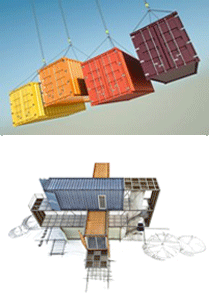- Home
- Building
- Transportation
- Dimensions
- Container Costs
- Used Containers
- 20 FOOT
- Book Store
- Container Sizes
- Companies
- Manufacturers
- Plans
- Drawings
- Used For Sale
- Projects
- Carriers
- Green House
- Benefits
- Construction
- Origins
- Design
- Specs
- Industry
- Refrigerated
- Cranes
- Open Tops
- Intermodal
- Insulated
- History
- Articles
- SCH Blog
- Contact us
- Submit your site
- Suggestions
- Privacy Policy
20 Foot Shipping Container
Even though the 20 foot shipping container was
never a favorite of truckers and has largely decreased in popularity for
international shipping, it remains an important size for several reasons.
One is its continued use as a basic unit of
shipping measure known as TEU. Another is its flexibility in the housing and
building arena, where the container is an efficient size for a number
of structures and functions.
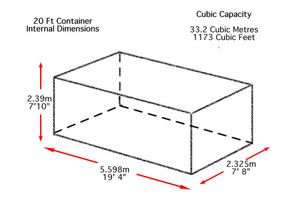 20ft Container Dimensions - Internal
20ft Container Dimensions - Internal20ft Container Dimensions
The 20 ft container's size makes it an ideal building unit for stand-alone structures as well as building or housing add-ons that don’t require an exceptionally large interior.
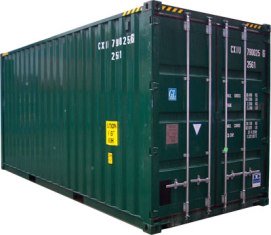 Standard 20 ft Container
Standard 20 ft ContainerExterior dimensions of a 20 foot container:
· Length: 20 feet
· Width: 8 feet
· Height: 8 feet 6 inches
Interior dimensions of a 20 foot container:
· Length: 19 feet 4 inches
· Width: 7 feet 8 inches
· Height: 7 feet 10 inches
Standard 20ft shipping containers come with a door opening that is 7 feet 8.125 inches wide and 7 feet 5.75 inches high.
20 Feet Container Volume
Multiplying the 20 foot container dimensions of length, height and width give you the 20 feet container volume. You want to focus on the interior dimensions to ensure accurate calculations. You also need to convert the measurements of inches into feet for easier calculations.
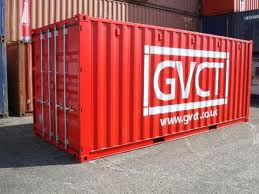 20' Shipping Container
20' Shipping Container· 20 Feet Container Volume = Interior Length x Height x Width
· 19 feet 4 inches x 7 feet 8 inches x 7 feet 10 inches
· 19.33 x 7.67 x 7.83 = 1,161 cubic feet
Your overall 20 ft container capacity is 1,161 cubic feet.
20 Feet Container CBM
CBM refers to cubic meter, and the measurement designates how many cubic meters can fit into a specified container. A cubic meter is a measure of volume, and it can consist of any combination of different lengths to reach the equivalent of an area that is 1 meter long, 1 meter wide and 1 meter high (or 1 meter squared).
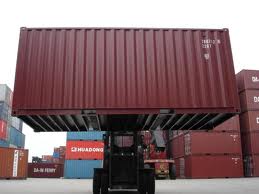 20 Foot Container
20 Foot ContainerA single meter is equivalent to approximately 3.28 feet, and 1 cubic meter is equal to approximately 35 cubic feet. You can calculate the 20 ft container CBM in various ways, with one of them being a conversion of your 20 foot container volume from cubic feet to cubic meters by dividing the cubic feet by 35.3 and 1 meter high (or 1 meter squared).
Using the 1,161 cubic feet calculated in the Volume section above, you divide the 1,161 by 35.3 to obtain a measurement of 33.2 CBM.
Your overall 20 ft container capacity is 33.2 CMB.
20 Foot Shipping Container Weight
As expected, the 20 foot shipping container is a
lightweight in the container world, especially when others are
double or more than double its length. Shipping container weight is
categorized into various measurements.
· Tare weight: The weight of the shipping container
· Net weight: The weight of the cargo or items inside the shipping container
· MGW: Maximum gross weight the shipping container can handle
A steel, dry cargo 20 foot shipping container has the following weights:
· Tare weight: 5,140 lbs.
· Net weight: 47,770 lbs.
· MGW: 52,910 lbs.
You may also find a heavier 20' shipping container that can dramatically increase your net weight and MGW.
· Tare weight: 5,290 lbs.
· Net weight: 61,910 lbs.
· MGW: 67,200 lbs.
20 Feet Container Size as Basic Shipping Measure
One of the shipping industry acronyms you may run across is TEU, which stands for twenty-foot equivalent unit. This measurement is based on the dimensions of a standard 20 foot shipping container that is 20 feet long and 8 feet wide, although the exact length and height of TEU may vary. TEUs can also be used to determine the cargo-carrying capacity of a ship or other means of transport.
Two TEUs are equal to one forty-foot equivalent unit, or FEU, another acronym you may run across during your shipping container research. Depending on the exact pallet size, anywhere from 9 to 11 pallets can typically fit in one TEU. Just to give you an idea of the scope of some of the world’s largest cargo ships, some can transport more than 14,000 TEUs. This would be equivalent to 7,000 FEUs, and up to 154,000 pallets of cargo.
20 Foot Shipping Container for Housing and Building Units
The dimensions of a 20 foot container make it an ideal size for various structures used in housing and building units.
As a stand-alone unit, the 20 ft container provides generally more than enough room for a laundry room combined with a bathroom, a detached home office, a portable office module that can be transported from site to site as needed, or even a storage unit for one or multiple families or businesses in a housing or office complex.
When
used as an addition to a home or other structure, the 20 foot container
dimensions lend themselves well to storage space and walk-in closets as well as
smaller bedrooms, larger bathrooms or a study, playroom, library, laundry room
or den.
Other uses may include portable shops, artist studios or small galleries that can be transported to different locations for fairs, festivals and other events that rent out space to vendors. The roomy door openings are large enough for customers to easily enter, and they can also be adapted to serve the needs of other stand-alone or connected structures.
Due to a size that fit neatly into converted World War II C-3 cargo ships, the 20 foot shipping container was the standard length used by Matson and other major shipping companies for a number of years. Truckers were never fond of the 20ft shipping containers, which were too short to fit efficiently on the truck beds. Although the use of 20 foot containers has largely fallen off in favor of the larger containers, the 20 footers remain an essential component in shipping container history with many creative uses outside of the shipping industry.
Shipping container dimensions Shipping container prices
You can learn more about container chassis, insulated containers or tank containers here.
